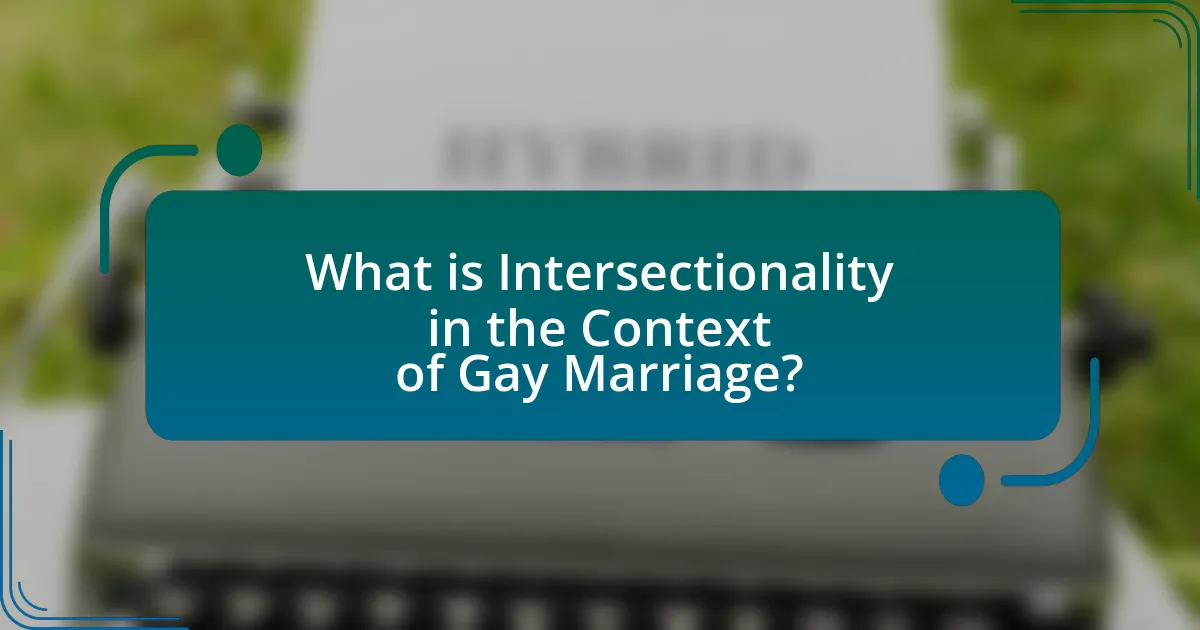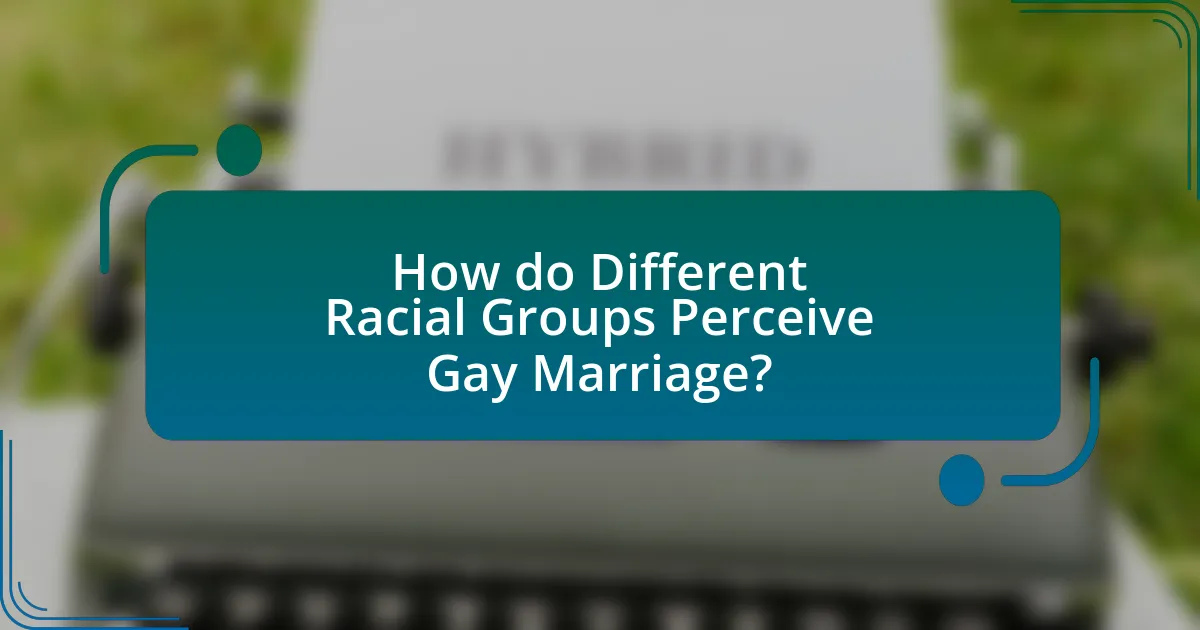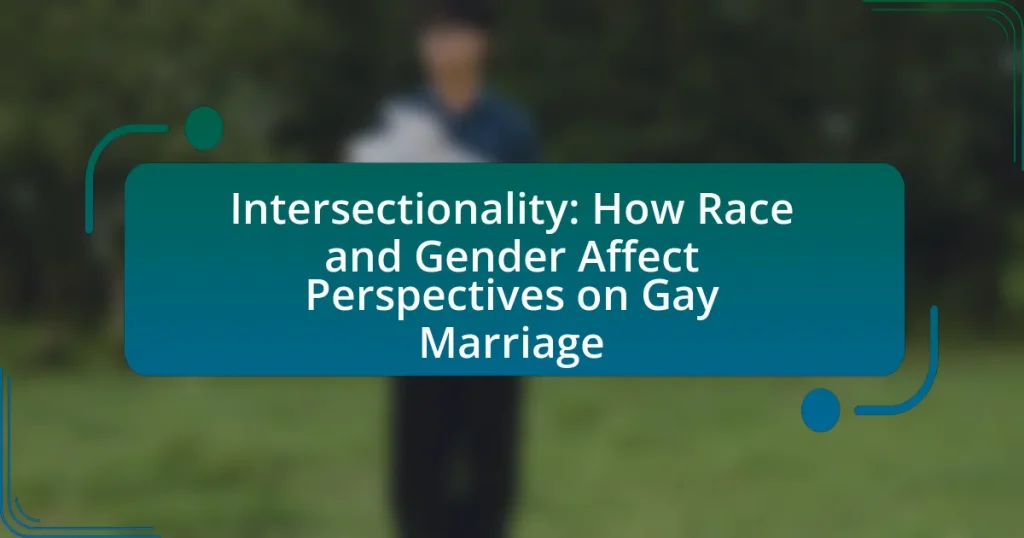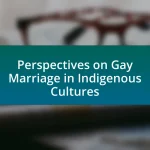The article examines the concept of intersectionality and its impact on perspectives regarding gay marriage, emphasizing how race and gender intersect to shape individual experiences and attitudes. It highlights that social categorizations create overlapping systems of discrimination, leading to varied challenges faced by different groups within the LGBTQ+ community. Key discussions include the influence of historical contexts, cultural beliefs, and socioeconomic factors on views of gay marriage among diverse racial groups, as well as the role of gender in shaping these perspectives. The article underscores the importance of understanding intersectionality for effective advocacy and public policy in the realm of marriage equality.

What is Intersectionality in the Context of Gay Marriage?
Intersectionality in the context of gay marriage refers to the interconnected nature of social categorizations such as race, gender, and sexual orientation, which create overlapping systems of discrimination or disadvantage. This concept highlights how individuals experience gay marriage differently based on their unique identities; for instance, a Black gay man may face distinct challenges compared to a white gay man due to systemic racism and homophobia. Research by Crenshaw (1989) emphasizes that understanding these intersections is crucial for addressing the complexities of social justice and equality within the LGBTQ+ community, particularly in legal and societal recognition of gay marriage.
How do race and gender intersect to shape views on gay marriage?
Race and gender intersect to shape views on gay marriage by influencing cultural beliefs, social norms, and individual experiences. For instance, research indicates that Black and Latino communities often hold more conservative views on gay marriage compared to white communities, influenced by religious beliefs and cultural traditions. A study by the Pew Research Center in 2020 found that 54% of Black Americans and 49% of Hispanic Americans opposed same-sex marriage, while only 36% of white Americans shared that view. Additionally, gender plays a significant role, as women generally express more support for gay marriage than men, with 70% of women supporting it compared to 61% of men according to the same Pew Research data. This intersection of race and gender creates a complex landscape where attitudes towards gay marriage are not uniform but rather shaped by a combination of cultural, social, and individual factors.
What historical contexts influence these intersecting identities?
Historical contexts that influence intersecting identities in the realm of race, gender, and perspectives on gay marriage include the civil rights movement, feminist movements, and LGBTQ+ rights activism. The civil rights movement of the 1960s highlighted racial inequalities and laid the groundwork for subsequent advocacy for LGBTQ+ rights, emphasizing the importance of intersectionality in understanding how race and gender shape individual experiences. Additionally, the feminist movements have historically addressed issues of gender inequality, which intersect with racial identities, influencing perspectives on marriage equality. The legalization of same-sex marriage in various countries, particularly following landmark rulings like Obergefell v. Hodges in the United States in 2015, further illustrates how these historical contexts shape contemporary views on gay marriage, as they reflect broader societal changes regarding race and gender equality.
How do personal experiences of race and gender affect individual perspectives?
Personal experiences of race and gender significantly shape individual perspectives by influencing how people perceive social issues, including those related to equality and rights. For instance, individuals from marginalized racial backgrounds may experience systemic discrimination, which can lead to a heightened awareness of social justice issues. Research by Crenshaw (1989) on intersectionality highlights that the overlapping identities of race and gender create unique experiences of oppression and privilege, affecting how individuals engage with topics like gay marriage. Furthermore, studies indicate that women of color often advocate for inclusive policies that consider both race and gender, reflecting their lived experiences and the need for intersectional approaches in social movements.
Why is understanding intersectionality important for the gay marriage debate?
Understanding intersectionality is important for the gay marriage debate because it highlights how various social identities, such as race, gender, and class, intersect to shape individuals’ experiences and perspectives on marriage equality. This framework reveals that the fight for gay marriage is not solely about sexual orientation; it also involves addressing systemic inequalities that affect marginalized communities. For instance, research by Crenshaw (1989) emphasizes that Black LGBTQ+ individuals face unique challenges that differ from those experienced by white LGBTQ+ individuals, thus necessitating a nuanced approach to advocacy that considers these intersecting identities. By acknowledging intersectionality, advocates can create more inclusive policies and strategies that address the diverse needs of all individuals affected by the gay marriage debate.
What role does intersectionality play in shaping public policy on gay marriage?
Intersectionality significantly influences public policy on gay marriage by highlighting how overlapping identities, such as race, gender, and socioeconomic status, affect individuals’ experiences and needs. This framework reveals that the struggles for marriage equality are not uniform; for instance, LGBTQ+ individuals of color often face compounded discrimination that can shape their advocacy and policy priorities differently than those of white LGBTQ+ individuals. Research indicates that policies informed by intersectional perspectives can lead to more inclusive legislation, as seen in states that consider the diverse experiences of marginalized communities when crafting laws related to marriage equality. This approach ensures that public policy addresses the unique barriers faced by various groups, ultimately fostering a more equitable legal landscape for all individuals seeking marriage rights.
How can intersectionality inform advocacy strategies for LGBTQ+ rights?
Intersectionality can inform advocacy strategies for LGBTQ+ rights by highlighting the interconnected nature of social categorizations such as race, gender, and sexual orientation, which can lead to overlapping systems of discrimination. This understanding allows advocates to tailor their approaches to address the unique challenges faced by individuals at these intersections, such as Black LGBTQ+ individuals who may experience both racial and sexual discrimination. Research indicates that advocacy efforts that consider intersectionality can lead to more inclusive policies and practices, as seen in the work of organizations like the Human Rights Campaign, which emphasizes the importance of addressing the specific needs of marginalized groups within the LGBTQ+ community. By integrating intersectional analysis, advocacy strategies can become more effective in promoting equity and justice for all individuals, ensuring that no one is left behind in the fight for LGBTQ+ rights.

How do Different Racial Groups Perceive Gay Marriage?
Different racial groups perceive gay marriage in varied ways, influenced by cultural, religious, and social factors. For instance, research indicates that Black Americans tend to support gay marriage at lower rates compared to White Americans, with a 2019 Gallup poll showing 49% of Black respondents in favor, contrasted with 70% of White respondents. In contrast, Hispanic Americans exhibit a more moderate stance, with support levels around 60%. These differences can be attributed to varying religious beliefs, community values, and historical contexts that shape attitudes toward LGBTQ+ rights within each racial group.
What are the varying attitudes towards gay marriage among different racial communities?
Attitudes towards gay marriage vary significantly among different racial communities. For instance, a 2020 Pew Research Center study found that Black Americans show more opposition to gay marriage compared to White Americans, with 43% of Black respondents supporting it versus 61% of White respondents. In contrast, Hispanic Americans exhibit a more moderate stance, with 54% in favor of gay marriage. These differences can be attributed to cultural, religious, and historical factors that shape the views of each community. For example, Black communities often emphasize traditional family structures influenced by religious beliefs, while Hispanic communities may have diverse perspectives influenced by varying levels of religious adherence and cultural integration.
How do cultural beliefs within these communities influence their perspectives?
Cultural beliefs within communities significantly shape their perspectives on issues such as gay marriage. For instance, communities with strong religious affiliations often view marriage as a sacred institution defined by traditional gender roles, leading to opposition against same-sex unions. Research by the Pew Research Center indicates that 70% of Black Protestants oppose same-sex marriage, reflecting how cultural and religious beliefs intertwine to influence attitudes. Additionally, cultural norms regarding masculinity and femininity can dictate acceptance levels, with some communities emphasizing heteronormative values that marginalize LGBTQ+ identities. Thus, cultural beliefs serve as a lens through which individuals interpret social issues, impacting their acceptance or rejection of concepts like gay marriage.
What role does religion play in shaping these attitudes?
Religion significantly influences attitudes toward gay marriage, often shaping beliefs and values regarding sexuality and family structures. Many religious doctrines promote traditional views of marriage as a union between a man and a woman, which can lead to opposition against same-sex marriage. For instance, surveys indicate that individuals who identify with conservative religious groups are more likely to oppose gay marriage compared to those from more liberal or secular backgrounds. This opposition is often rooted in specific interpretations of religious texts, such as the Bible or the Quran, which are cited to justify traditional marriage norms. Additionally, religious communities can reinforce these attitudes through teachings, community norms, and socialization processes, further entrenching resistance to gay marriage within certain demographics.
How do socioeconomic factors impact racial perspectives on gay marriage?
Socioeconomic factors significantly influence racial perspectives on gay marriage, as individuals from different economic backgrounds often have varying levels of education, access to information, and exposure to diverse viewpoints. For instance, research indicates that higher socioeconomic status correlates with more progressive views on social issues, including gay marriage. A study by the Pew Research Center found that 70% of individuals with a college degree support gay marriage, compared to only 40% of those without a high school diploma. Additionally, racial minorities, particularly in lower socioeconomic brackets, may hold more traditional views due to cultural and religious influences, which can be reinforced by economic instability. Thus, socioeconomic status shapes the context in which racial groups form their opinions on gay marriage, leading to a complex interplay between economic conditions and cultural beliefs.
What is the relationship between economic status and views on LGBTQ+ rights?
Economic status significantly influences views on LGBTQ+ rights, with higher economic status often correlating with more supportive attitudes. Research indicates that individuals with greater financial resources tend to have more exposure to diverse perspectives and experiences, leading to increased acceptance of LGBTQ+ rights. For instance, a study by the Pew Research Center found that 72% of individuals with a household income above $75,000 support same-sex marriage, compared to only 45% of those earning less than $30,000. This disparity highlights how economic factors can shape social attitudes and beliefs regarding LGBTQ+ rights.
How do access to education and resources affect opinions on gay marriage?
Access to education and resources significantly influences opinions on gay marriage, with higher levels of education correlating with more supportive views. Research indicates that individuals with college degrees are more likely to endorse same-sex marriage compared to those with only a high school education. For instance, a 2020 Pew Research Center study found that 70% of college-educated adults supported gay marriage, while only 45% of those without a college degree did. Additionally, access to resources such as LGBTQ+ advocacy groups and inclusive educational materials fosters understanding and acceptance, further shaping positive attitudes toward gay marriage.

What is the Role of Gender in Shaping Perspectives on Gay Marriage?
Gender plays a significant role in shaping perspectives on gay marriage, influencing attitudes through socialization, cultural norms, and personal experiences. Research indicates that women generally exhibit more supportive views towards gay marriage compared to men, often attributed to differing socialization processes and empathy levels. For instance, a 2019 study published in the Journal of Marriage and Family found that women are more likely to prioritize equality and social justice, leading to higher acceptance of same-sex marriage. Additionally, gender identity intersects with sexual orientation, affecting how individuals perceive and advocate for gay marriage rights, as seen in the activism of LGBTQ+ women who often challenge both gender and sexual orientation norms.
How do gender identities influence views on gay marriage?
Gender identities significantly influence views on gay marriage, as individuals’ beliefs about marriage often reflect their own experiences and societal roles associated with their gender. For instance, research indicates that individuals who identify as LGBTQ+ are generally more supportive of gay marriage compared to heterosexual individuals, as they seek recognition and validation of their relationships. Additionally, gender non-conforming individuals may advocate for broader definitions of marriage that challenge traditional norms, emphasizing equality and inclusivity. Studies, such as those conducted by the Pew Research Center, show that support for gay marriage varies across different gender identities, with women typically expressing higher levels of support than men. This disparity highlights how gender identity shapes perspectives on marriage equality, reinforcing the importance of considering intersectionality in discussions about gay marriage.
What differences exist between male and female perspectives on this issue?
Male and female perspectives on gay marriage often differ significantly due to socialization, cultural expectations, and personal experiences. Research indicates that women are generally more supportive of gay marriage than men, with a 2020 Gallup poll showing that 70% of women favor legal recognition compared to 61% of men. This disparity can be attributed to women’s greater emphasis on equality and social justice, influenced by feminist movements that advocate for LGBTQ+ rights. Additionally, men may hold more traditional views shaped by societal norms regarding masculinity, which can lead to resistance against non-heteronormative relationships. These differences highlight how gender influences attitudes toward gay marriage within the broader context of intersectionality.
How do non-binary and transgender individuals view gay marriage?
Non-binary and transgender individuals often view gay marriage as a significant step toward equality and recognition of diverse relationships. Many in these communities appreciate the legal and social validation that marriage provides, as it can affirm their identities and relationships in a society that has historically marginalized them. Research indicates that acceptance of same-sex marriage among transgender and non-binary individuals is generally high, with studies showing that over 70% support marriage equality, recognizing it as a vital aspect of broader LGBTQ+ rights. This perspective is rooted in the desire for inclusivity and the acknowledgment of varied gender identities within the institution of marriage.
What impact does gender socialization have on attitudes towards gay marriage?
Gender socialization significantly influences attitudes towards gay marriage by shaping individuals’ beliefs and values regarding gender roles and relationships. Research indicates that individuals socialized in traditional gender norms often hold more negative attitudes towards gay marriage, as these norms emphasize heterosexuality and rigid gender roles. For instance, a study published in the Journal of Marriage and Family found that individuals with strong adherence to traditional gender roles were less supportive of same-sex marriage compared to those with more egalitarian views. This correlation suggests that the process of gender socialization directly impacts societal acceptance of gay marriage, reinforcing the idea that attitudes towards same-sex unions are intertwined with broader gender norms and expectations.
How do traditional gender roles affect acceptance of LGBTQ+ relationships?
Traditional gender roles significantly hinder the acceptance of LGBTQ+ relationships by enforcing rigid expectations about masculinity and femininity. These roles dictate that men should be dominant and heterosexual, while women should be nurturing and submissive, creating a societal framework that marginalizes non-conforming identities. Research indicates that societies with strict adherence to traditional gender norms often exhibit higher levels of homophobia and discrimination against LGBTQ+ individuals, as seen in studies conducted by the Williams Institute, which found that areas with more traditional views on gender roles correlate with lower acceptance of same-sex relationships. This dynamic perpetuates stigma and reinforces barriers to equality, impacting the overall social acceptance of LGBTQ+ relationships.
What are the implications of gender stereotypes in the gay marriage debate?
Gender stereotypes significantly influence the gay marriage debate by shaping societal perceptions and attitudes towards LGBTQ+ relationships. These stereotypes often dictate traditional roles within relationships, leading to biases that can undermine the legitimacy of same-sex unions. For instance, the stereotype that men should be dominant and women submissive can create challenges for gay couples who do not conform to these roles, resulting in societal pushback against their marriage rights. Research indicates that such stereotypes can perpetuate discrimination, as seen in studies showing that individuals who adhere to traditional gender norms are less supportive of gay marriage (Herek, 2000, “Sexual Prejudice in Contemporary America: Attitudes Toward Lesbians and Gay Men”). This reinforces the notion that gender stereotypes not only affect individual relationships but also impact broader legal and social acceptance of gay marriage.
How can understanding intersectionality improve advocacy for gay marriage?
Understanding intersectionality can improve advocacy for gay marriage by highlighting the diverse experiences and challenges faced by individuals at the intersection of multiple identities, such as race, gender, and sexual orientation. This nuanced perspective allows advocates to address the specific needs of marginalized groups within the LGBTQ+ community, ensuring that their voices are heard and their rights are prioritized. For instance, research indicates that Black LGBTQ+ individuals often face compounded discrimination, which can inform targeted advocacy strategies that resonate with their unique experiences. By incorporating intersectional analysis, advocacy efforts can become more inclusive and effective, ultimately leading to broader support for gay marriage across different demographics.
What strategies can be employed to address the needs of diverse communities?
To address the needs of diverse communities, inclusive engagement strategies must be employed. These strategies include actively involving community members in decision-making processes, ensuring representation across various demographics, and tailoring services to meet specific cultural and social needs. Research indicates that participatory approaches, such as community forums and focus groups, enhance trust and collaboration, leading to more effective outcomes (Brodsky et al., 2019, “Community Engagement in Diverse Populations,” Journal of Community Psychology). By prioritizing the voices of marginalized groups, organizations can better understand and respond to the unique challenges faced by these communities.
How can intersectional approaches enhance coalition-building among activists?
Intersectional approaches enhance coalition-building among activists by recognizing and addressing the diverse identities and experiences that shape individuals’ perspectives on social issues. This inclusivity fosters solidarity among various groups, as it allows activists to understand how overlapping social categories, such as race, gender, and sexual orientation, influence their struggles. For example, research by Crenshaw (1989) highlights that Black women face unique challenges that differ from those experienced by white women or Black men, emphasizing the need for coalitions that reflect these complexities. By integrating intersectionality into their frameworks, activists can create more effective alliances that address the specific needs of marginalized communities, ultimately leading to stronger, more unified movements.


